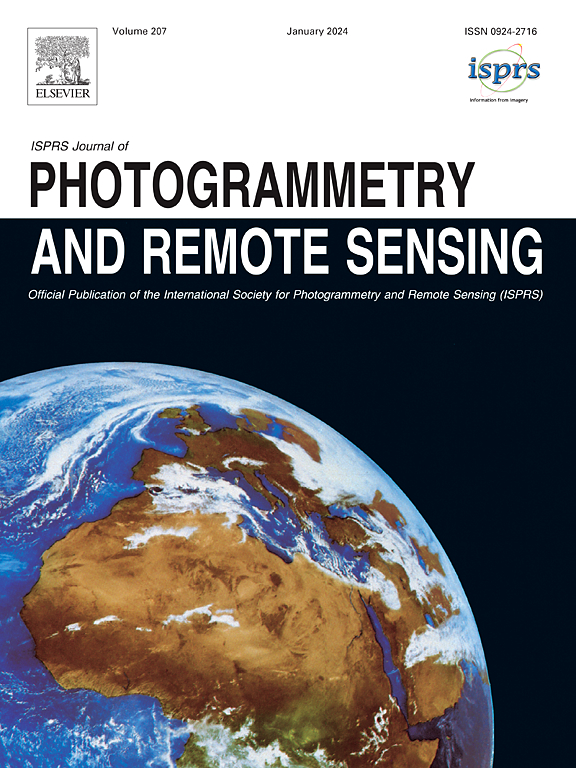HyperDehazing:高光谱图像去雾基准数据集和用于去除雾霾的深度学习模型
IF 10.6
1区 地球科学
Q1 GEOGRAPHY, PHYSICAL
ISPRS Journal of Photogrammetry and Remote Sensing
Pub Date : 2024-10-05
DOI:10.1016/j.isprsjprs.2024.09.034
引用次数: 0
摘要
雾霾污染严重降低了光学遥感(RS)图像(包括高光谱图像)的质量和精度。目前,在高光谱图像去噪中还没有包含雾霾和无雾霾场景的配对基准数据集,也很少有研究分析雾霾在空间和光谱领域的分布特性。在本文中,我们开发了一种新的雾度合成策略,并构建了第一个高光谱去雾基准数据集(HyperDehazing),其中包含 2000 对合成 HSI(覆盖 100 个场景)和另外 70 个真实雾度 HSI。通过分析雾霾的分布特征,我们进一步提出了一种名为HyperDehazeNet的深度学习模型,用于从高光谱图像中去除雾霾。该模型采用了对雾霾不敏感的长波信息注入、新颖的注意力机制、光谱损失函数和残差学习等方法来提高去雾霾和场景重建能力。全面的实验结果表明,HyperDehazing 数据集有效地表现了真实场景中的复杂雾霾,具有合成真实性和场景多样性,成为训练和评估 HSI 去雾霾方法的新基准。在 HyperDehazing 数据集上的实验结果表明,我们提出的 HyperDehazeNet 能有效去除 HSI 中的复杂雾度,并具有出色的光谱重建和特征区分能力。此外,在真实的 HSI 以及广泛使用的 Landsat-8 和 Sentinel-2 数据集上进行的其他实验也证明了 HyperDehazeNet 卓越的去雾性能和强大的泛化能力。我们的方法计算效率高、参数数量少,超越了其他最先进的方法。本文章由计算机程序翻译,如有差异,请以英文原文为准。
HyperDehazing: A hyperspectral image dehazing benchmark dataset and a deep learning model for haze removal
Haze contamination severely degrades the quality and accuracy of optical remote sensing (RS) images, including hyperspectral images (HSIs). Currently, there are no paired benchmark datasets containing hazy and haze-free scenes in HSI dehazing, and few studies have analyzed the distributional properties of haze in the spatial and spectral domains. In this paper, we developed a new hazy synthesis strategy and constructed the first hyperspectral dehazing benchmark dataset (HyperDehazing), which contains 2000 pairs synthetic HSIs covering 100 scenes and another 70 real hazy HSIs. By analyzing the distribution characteristics of haze, we further proposed a deep learning model called HyperDehazeNet for haze removal from HSIs. Haze-insensitive longwave information injection, novel attention mechanisms, spectral loss function, and residual learning are used to improve dehazing and scene reconstruction capability. Comprehensive experimental results demonstrate that the HyperDehazing dataset effectively represents complex haze in real scenes with synthetic authenticity and scene diversity, establishing itself as a new benchmark for training and assessment of HSI dehazing methods. Experimental results on the HyperDehazing dataset demonstrate that our proposed HyperDehazeNet effectively removes complex haze from HSIs, with outstanding spectral reconstruction and feature differentiation capabilities. Furthermore, additional experiments conducted on real HSIs as well as the widely used Landsat-8 and Sentinel-2 datasets showcase the exceptional dehazing performance and robust generalization capabilities of HyperDehazeNet. Our method surpasses other state-of-the-art methods with high computational efficiency and a low number of parameters.
求助全文
通过发布文献求助,成功后即可免费获取论文全文。
去求助
来源期刊

ISPRS Journal of Photogrammetry and Remote Sensing
工程技术-成像科学与照相技术
CiteScore
21.00
自引率
6.30%
发文量
273
审稿时长
40 days
期刊介绍:
The ISPRS Journal of Photogrammetry and Remote Sensing (P&RS) serves as the official journal of the International Society for Photogrammetry and Remote Sensing (ISPRS). It acts as a platform for scientists and professionals worldwide who are involved in various disciplines that utilize photogrammetry, remote sensing, spatial information systems, computer vision, and related fields. The journal aims to facilitate communication and dissemination of advancements in these disciplines, while also acting as a comprehensive source of reference and archive.
P&RS endeavors to publish high-quality, peer-reviewed research papers that are preferably original and have not been published before. These papers can cover scientific/research, technological development, or application/practical aspects. Additionally, the journal welcomes papers that are based on presentations from ISPRS meetings, as long as they are considered significant contributions to the aforementioned fields.
In particular, P&RS encourages the submission of papers that are of broad scientific interest, showcase innovative applications (especially in emerging fields), have an interdisciplinary focus, discuss topics that have received limited attention in P&RS or related journals, or explore new directions in scientific or professional realms. It is preferred that theoretical papers include practical applications, while papers focusing on systems and applications should include a theoretical background.
 求助内容:
求助内容: 应助结果提醒方式:
应助结果提醒方式:


